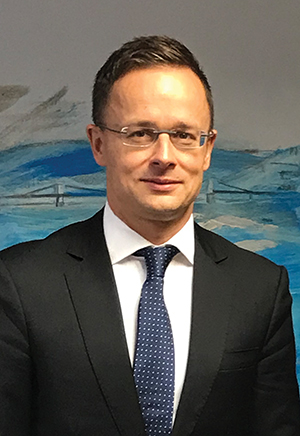On February 11th, U.S. Secretary of State Michael Pompeo was in Budapest, Hungary, where he met with Prime Minister Viktor Orbán; Foreign Minister Péter Szijjártó, whose portfolio includes economic development; and others. The Secretary was in Central Europe shoring up ties with U.S. allies in the region that don’t make economic and political headlines to the degree their larger, western EU counterparts do. Pompeo was no doubt impressed with Péter Szijjártó’s grasp of all things security, defense, economic development and trade-related.

He should be. Szijjártó, 40, is a rising star in European politics whose approach to economic and foreign affairs is increasingly admired — and being implemented — in comparably sized countries. A former registered futsal player, Szijjártó has served in the Hungarian Parliament since 2002. In fall 2018, Site Selection Editor in Chief Mark Arend met with Minister Szijjártó at Hungary’s consulate in New York. Following are highlights of that discussion.
Your title — Minister of Foreign Affairs and Trade — suggests a rather broad portfolio. Typically, these are separate functions or ministries. Explain the rationale behind linking the two.
Minister of Foreign Affairs Péter Szijjártó: Hungary has a very open economy. Our export-over-GDP ratio is about 90 percent. The FDI per capita is US$8,600 — it’s very high. Overall FDI stock is €86 billion. External factors play an extremely important role when it comes to the economic performance of the country. We are a small country, and no one really expects us to offer solutions to global issues. That’s why I recommended to the prime minister that we use our structure of foreign policy to serve the national economic interest, and to give an economic focus to the foreign policy itself.
Institutionally, this was expressed in a way that foreign affairs and economic relations were put under one portfolio. In Hungarian, my title is Minister of Economic Relations and Foreign Affairs — sequencing counts. That means foreign affairs must serve the national economic interest. The main function is help Hungarian companies be successful in external markets and to attract the best possible investments to Hungary. All government policies, including foreign policy, must serve the goal of making available more and more prestigious jobs for the Hungarian people.
How does this translate into practice at Hungary’s embassies and consulates around the world?
Szijjártó: I am a man of figures, and I would rather believe in facts and figures than in perceptions. Since 2014, when we merged these portfolios, we have broken all external related economic records, year after year — investments, jobs created — every year. Last year [2017] was the first year ever Hungarian exports exceeded €100 billion; GDP is about €130 billion. Also that year, 96 major investments came to the country through our investment promotion network. The previous record was 71 the year before that. [2018 saw 98 projects land in Hungary — Ed.] I told my ambassadors at the very beginning that they would not be judged by me based on the number of receptions you take part in, but rather on figures related to helping us attract investors to Hungary, and on whether they helped some Hungarian companies gain more market access.
“In Hungarian, my title is Minister of Economic Relations and Foreign Affairs – sequencing counts.”
In all of our embassies around the world, there must be at least one economic consular. In Germany, we have four, and in the U.S. we have six. A lot of foreign minister friends of mine ask me for this recipe. The foreign minister of Tunisia, for example, wants to reorganize their system the way we are operating, so my deputy foreign minister spent a day there giving a presentation to them about how it works. Some in the embassies see this role as a merchandiser, as a downgrade. But it is an upgrade if you have more concrete tasks in helping your country’s interests get reached in the international arena.
How personally involved do you get in inward capital investment negotiations?
Szijjártó: 100 percent. I usually negotiate with foreign investors directly. And I’m very happy to do it. I made a lot of effort to attract some people from the business world to work for me. Our current ambassador in Washington, for example, Dr. László Szabó, was CEO of Hungarian pharmaceutical company TEVA, and before that was vice president at Eli Lilly in the U.S. The current president of the investment promotion agency was Hungary country director for Nokia. The investors have more trust in them.
I very recently negotiated for 14 months with BMW about their new factory in Hungary. And I’m in continuous dialogue with the highest-ranking leaders of the big investors in Hungary. I always want to collect experiences from them. It’s easier to ask them what they think should be modified, what kind of legislative acts should be made, which amendments should be pushed through in order to make the environment more competitive.
What do investors tell you about their experience of investing in Hungary?
Szijjártó: What they like in Hungary is the low taxes, for sure. We have a flat tax in Hungary, both corporate and personal. Our personal tax rate is 15 percent, and our corporate income tax rate is 9 percent. I proposed this 9 percent to the prime minister based on American inspiration. When I understood that President Trump would carry out the most patriotic economic policy ever, I understood that I have to give additional arguments to the investors in Hungary to stay. About 1,700 U.S. companies operate in Hungary, employing 105,000 people. This is the only single-digit corporate tax rate in Europe. We introduced it in 2017 — in 2016 we had 71 big investments and in 2017 we had 96, which shows the significance of this change.
Also, they benefit from a wide variety of cash incentives. In the western part of the country we can finance up to 25 percent of the volume of the investment in cash. In the eastern part we can finance up to 50 percent of the volume of the investment in cash. The difference is because the western part is much more developed, with a roughly zero percent unemployment rate. On the eastern side, we still have capacity. In Budapest we can only finance R&D-related investments.
They like the very flexible labor code in Europe, which takes into consideration the interests of both employers and employees, which is a rare phenomenon.
They put forward as a challenge the full employment in the country. When we came into office in 2010, the unemployment rate was 12.5 percent. Now it’s below 3.5 percent. This definitely poses a challenge, but a good one. The way we address this is the restructuring of higher education. We are radically increasing the number of state-financed seats for engineering, mathematics, IT and related fields. And we have introduced the German type of vocational training in the high schools already. Those students can be involved in a curriculum put together by companies. When they leave school, they will have the necessary skills.
We have introduced a broad scheme of training subsidies — up to €3,000 per capita for the companies. If they train their own employees, then we finance it. We are now preparing a new set of measures together with the Minister of Innovation and Technology where we will end up in a more flexible regulation of the labor code. That’s how the labor pool will be widened.
How are economic, fiscal and other forces at work elsewhere in Europe affecting Hungary’s agenda for prosperity?
Szijjártó: There are some efforts coming from the western part of Europe — countries that understand that they are losing the competitive advantages compared to central Europe — they are pushing for things like tax harmonization, which we totally object to. It is not for free that we are able to decrease taxes. In order to do that fiscally, you have to be extremely disciplined. There are countries in the western part of Europe that cannot get rid of this welfare state concept, that base their budgets on fiscal irresponsibility and on huge wealth redistribution. No wonder they cannot decrease tax rates. Instead of carrying out disciplined budgetary policies so they can cut taxes, they try to put pressure on the Eastern Europeans to increase our tax rate, which is unacceptable. Since something like tax harmonization requires a unanimous decision, it won’t happen.
“It is not for free that we are able to decrease taxes. In order to do that fiscally, you have to be extremely disciplined.”
In order to have a strong Hungary we need a strong European Union. We have a 90 percent export-over-GDP ratio, and 79 percent of our export goes to the EU. Trade between Germany and the four countries of Poland, Hungary, Czech Republic and Slovakia in 2017 was 60 percent higher than trade between Germany and France. Trade between these four countries and Germany was twice as much as German-British and German-Italian trade. The Central European countries basically became the backyard of German industry, which is the backbone of the European economy. We are so strongly interlinked with the German economy that it is extremely important for us to have a strong EU and a strong German economy, and these are helping Hungary.
Automotive manufacturing has been the backbone of Hungary’s industrial economy for many years. Is Hungary too dependent on this sector?
Szijjártó: Until now, we have been in a period of what we call Made in Hungary. Now we are stepping into a period we call Invented in Hungary. We understand that there is a global industrial revolution going on resulting in technologies in use on a daily basis that would not have been imaginable a couple of years ago. These technologies will be the core basis of competitiveness and of success. It is great luck, then, that our economy is based on the automotive industry, because automotive leads this new revolution.
Since we have very strong automotive capacities in the country, these companies are basing their research and development functions in Hungary based on their very good experience with manufacturing so far. Having such a robust presence of the automotive industry helps Hungary to be a flagship of this new digital economic era. This is a huge opportunity for success. Currently, 29.3 percent of industrial output comes from the automotive sector, and the biggest companies now are locating their R&D facilities for electromobility and autonomous vehicles to Hungary. We are now building a test environment that will be unique in Europe. Their autonomous driving will be able to be tested not only under highway circumstances but in urban settings as well. We’re building a ghost city where all kinds of events and developments will be produced to match what can happen in real life. Traffic lights, pedestrians, cars coming from here and there … it’s unique, and the automotive companies like that. Audi has located production of its electric engines to Hungary, for example. The robust presence of the automotive industry is an advantage.
Also, the number of jobs created in various other sectors of the economy because of the presence of automotive is similar. More companies are placing their shared services centers in Hungary because they understand that the level of technology, the added value, the knowledge of language, the very international environment associated with the automotive industry are very helpful.

